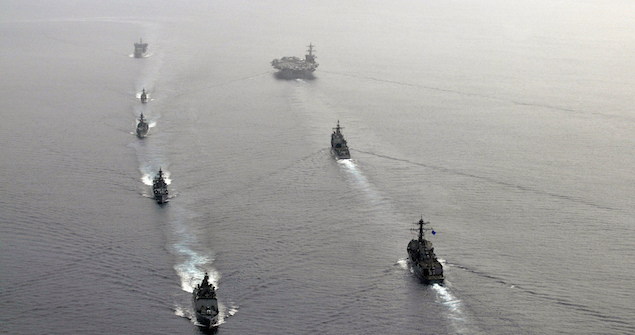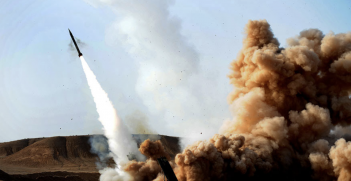Australian Maritime Strategy: Ambitions and Lessons

The 2013 Australian Defence White Paper contains a range of limitations.
The 2013 Australian Defence White Paper makes the following claim about the status of the new amphibious assault ships (LHDs) in contributing to Australia’s amphibious operation capability:
“The introduction of Australia’s two new Canberra Class Landing Helicopter Dock Ships in the middle of this decade will be a significant milestone in the development of the ADF’s capacity to deploy and sustain military power across a range of contingencies”.
However, it also claims that, “Australia’s amphibious capability will focus on security, stabilisation, humanitarian assistance and disaster relief tasks”, yet at the same time makes reference to “maritime strategy” and “future development”.
The discourse surrounding the acquisition and deployment of amphibious assets has been contradictory and murky. Interplay between concepts such as the development of a maritime/littoral strategy, power projection, continental defence, ambitious acquisition and limited deployment has obscured the current status as well as future potential of Australian amphibious assets.
Within the last several decades, there has been a conscious effort to establish a “maritime strategy” defined by Jonathan Hawkins as “the ability of a nation to project power from the sea in order to influence events upon the land”. Although there has been a strategic directive for such a maritime strategy in Australia, there has been a divergence of aims between the services. Traditionally, the Royal Australian Navy has been more concerned with developing sea-denial tactics, while the Army has elevated continental defence as their primary concern.
It is clear that without a binding, long-term commitment to changing the core operational culture of the ADF, each service will inevitably steer itself to exploit its traditional, conventional niches. When higher level planning goes back and forth, and is ambivalent about acquisition and capability planning, it further harms the development of maritime thinking in Australia. As such, the current and future status of the LHD’s, as well as their committed supporting resources, need to be critically analysed in view of Australia’s strategic aims, and needs, alongside the actual capacity that these acquisitions offer. Even significant spending on defence materiel can be counterproductive unless it is accompanied by a vision which aims to transcend each service’s individual interests to create a power projection capability suited for future challenges.
Australia is particularly vulnerable to having such deep-rooted institutional inefficiencies due to its strategic culture. There is a profound dissonance which has characterised Australian strategic thinking, whereby geography clashes with geopolitics and defence planning clashes with foreign policy interests. This is particularly worrying since dissonance in planning a joint-service strategy manifests itself as an inefficient return on each dollar spent. As Michael Evans asserts, it may be particularly hard for Australian strategic thinking to reconcile its needs and its capabilities, given the Australian ethos of having a “martial tradition” without necessarily having a proper conception of “self defence” and national interest.
Developing a truly joint approach to “littoral intervention” is an issue of importance since humanitarian relief and high intensity counterinsurgency can be encountered within a single operation. David Kilcullen highlights the manner in which coastal megacities and the sea surrounding them are increasingly becoming the flashpoints of conflict and instability. His shows that a conventional, overly specialised amphibious force may find itself outpaced and irrelevant in future conflicts.
The 2013 White Paper’s supposed claim to develop an amphibious force geared primarily towards peacekeeping is a half-measure that does not fully account for the complexity of potential future conflict scenarios. Indeed, Australia’s intervention in east Timor in 1999 shows how a littoral operation can move from supporting UN or coalition partners, to an amphibious evacuation interspersed with hostile contact. Unless the ADF is prepared to take risks with the lives of its personnel, contingency planning needs to expect the worst-case scenario.
There is no obvious answer that emerges about Australia’s future as a maritime power. In each case there are trade-offs and compromises stemming from a lack of clear vision from the highest policy levels in Australian strategic thinking. If Australia is to truly embrace the multi-dimensionality and importance of future littoral conflict, while ensuring personnel are protected, an amphibious force requires a clear-sighted, integrated and joint-service maritime strategy underpinning the program. This calls for a rethinking of the current plans for the LHDs, which cannot be expected to provide the vital capabilities necessary for future littoral conflict (such as organic air cover) without considerable continued investment. The 2015 Defence White paper will be a pivotal point in defining the way that the Australian leadership tackles this issue and we can only hope that these necessary but difficult considerations are taken on board. It may not be possible to possess world-class, future proof amphibious capacity without politically ruinous levels of funding and reform. However, a bold implementation of a maritime strategy for Australia would be a cultural and doctrinal shift involving joint service commitment and a long-term vision.
Kirill Kovalenko holds a Master of International Relations from the University of Melbourne and is a former Intern at Royal United Services Institute (RUSI) Victoria. This article can be republished with attribution under a Creative Commons Licence.





